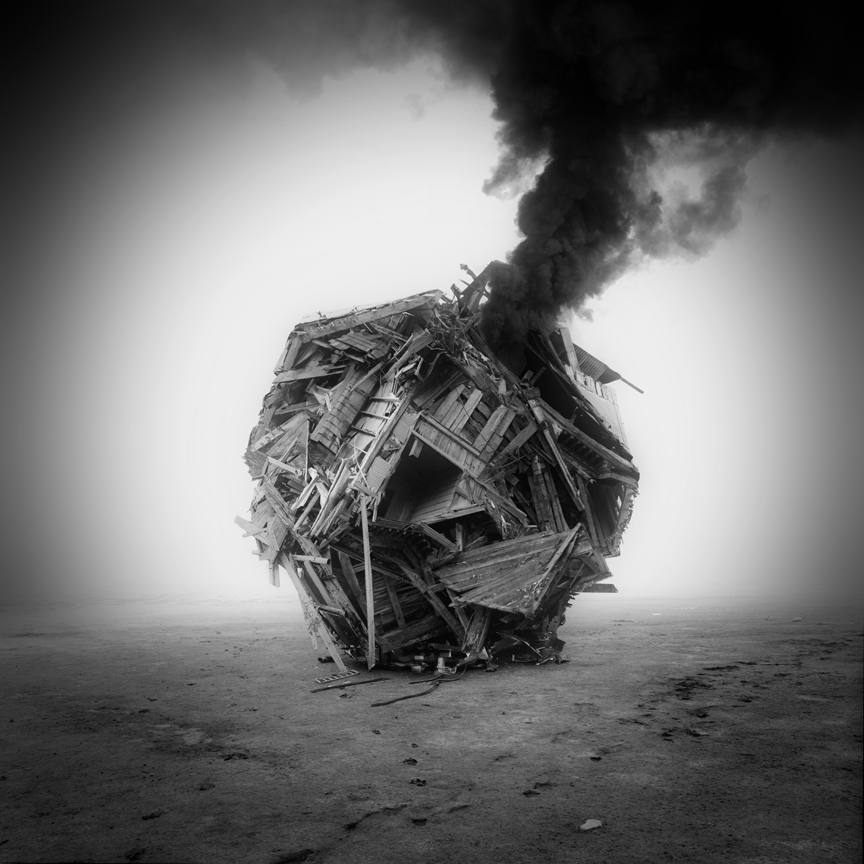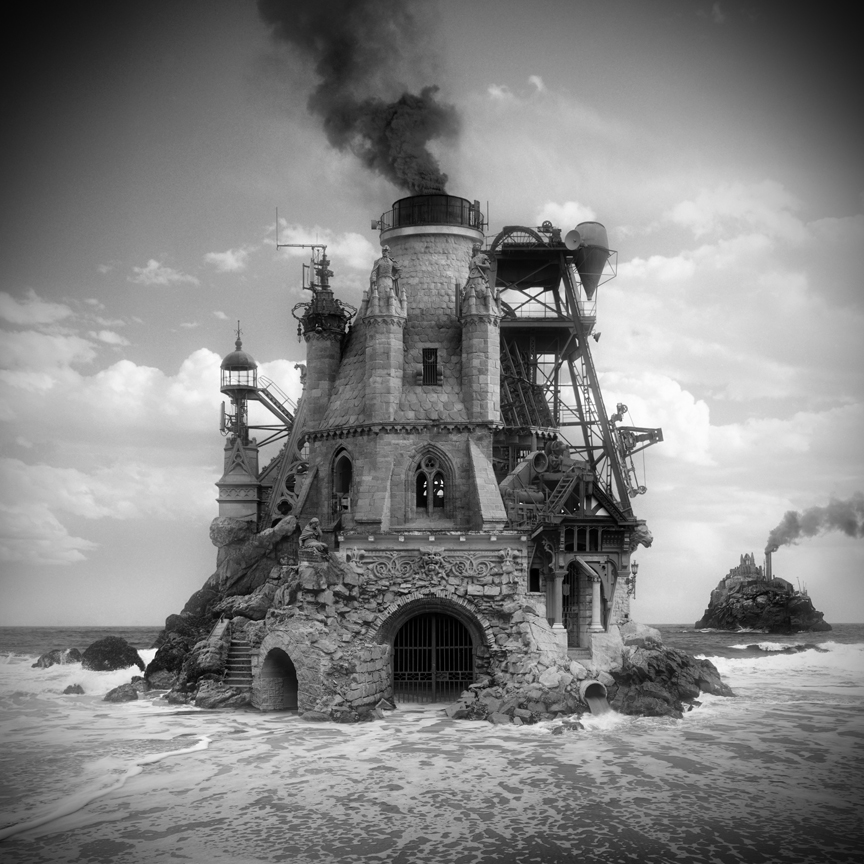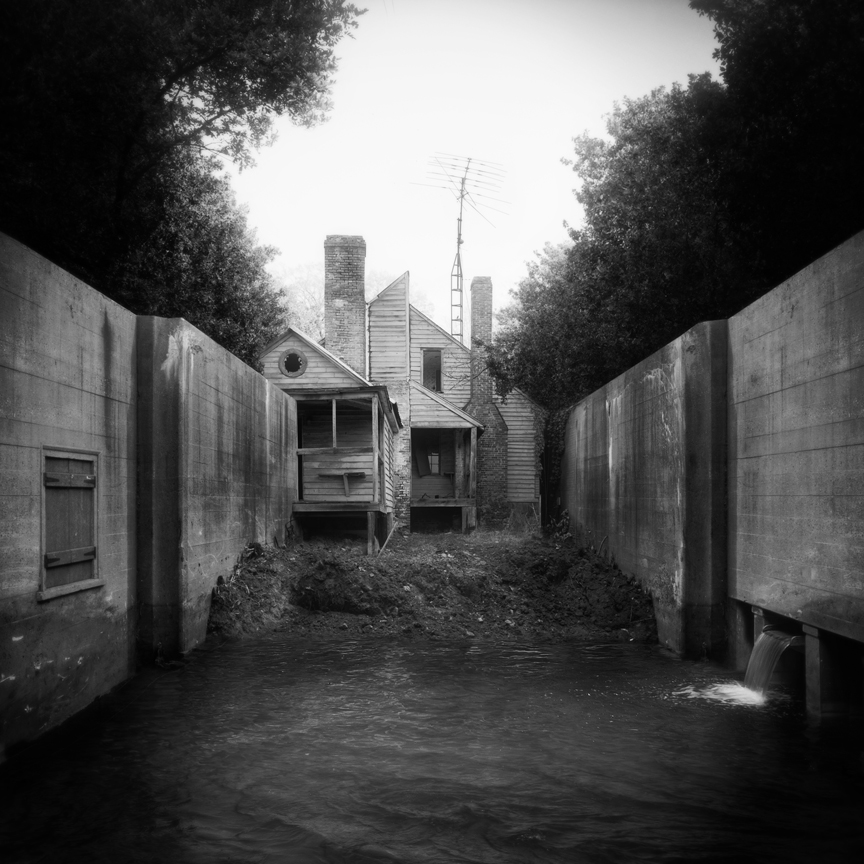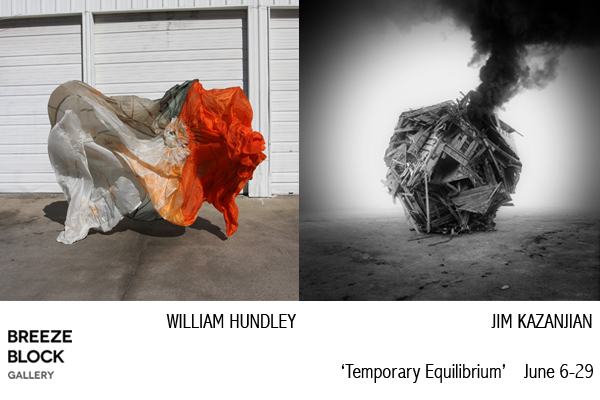When you first realize that the subject matter within Jim Kazanjian’s work doesn’t actually exist, you may at first be relieved that such precarious looking locations aren’t out there. Your next thought may well be “just how the hell does he do that”? Kazanjian works in photography, but is not a photographer. His tools include the internet for sourcing his library of over 25,000 high resolution images and Photoshop to assemble his impossible architecture compositions. He describes his creative process as hyper-collage.
He has a two-person exhibition along with photographer William Hundley featuring his manipulated landscapes entitled Temporary Equilibrium, opening on June 6th at Portland’s Breeze Block Gallery.
AM put some questions to Jim to try and understand his process a little better.
AM: I understand that you cite H. P. Lovecraft as an influence amongst others and that your background is as a commercial CGI artist. Can you tell us a little about how these things along with your art schooling have led you to arrive at your very distinctive aesthetic?
JK: That is difficult to say. It was kind of an amorphous process that developed over a long period of time. Technology plays a big part as well. The way I approach and build my work now was not even possible ten years ago. At its core, though, is my fascination with the sublime, death and the 4th dimension.
AM: You’re not a photographer in the traditional sense of the word, but your output is of course photography based. How did you come to be working with your medium of choice?
JK: Photography is a really amazing medium. It has this tenuous link with time, through physics, which I think is very potent and misleads us into viewing it as an objective ‘document’. I’m interested in using that misconception to generate visual tension in my work. It helps make things resonate.
AM: I’ve read before that you don’t use your own photography for the composites that you make. Have you ever found yourself needing just that special detail that you’ve been unable to find online and you’ve had to go out and shoot something yourself just to satisfy a particular itch? I know I’m a fiend for architectural detail. I often take pictures when I come across a clever detail to remind me of how the architect or engineer found a solution to a particular problem…
JK: I don’t use a camera. My whole process is about harvesting visual data, chopping it up and recombining it into something else. It is essentially ‘collage’ but my tools are entirely digital. The photos are digital. Everything is, at the root of it, all zeros and ones. It is just code. The best part of it is I can find everything I need online. I never have to leave the studio.
AM: Your work has a post-apocalyptic feel to it, and it’s kind of otherworldly with familiar features used as elements in unfamiliar ways. As I’m an architect, your work initially grabbed my attention with the ‘impossible architecture’ that you present. What is it that piques your interest in the subject matter?
JK: I see architecture as a vehicle for narrative. In this sense, the strucures are designed to be spectacles. I’m using them as devices to lure the viewer into the ‘photograph’. There is a seductive element to it, a mystery that is about to unfold. I’m interested in building a specific ambiance where the image begins to kind of unravel.
AM: Do you have any favourite ‘real’ examples of architecture you enjoy – impossible or otherwise?
JK: Most abandoned buildings, especially hotels and themeparks. Anything Victorian. Municpal sewer systems. Gaudi. Disneyland. These are just a few things that come to mind.
AM: Aside from the buildings and landscapes, you also have a series of abstracts. These also utilise common elements of structure. Personally, I enjoy these pieces just as much as the landscapes. Can you tell us more about this series?
JK: Those are actually labyrinths. I want to return to them at some point. It is something I’m still developing.
AM: Can you describe your studio practice? I’m intrigued at how many hours of studio time you put into each piece of work, and we talked about recently how your work can be very solitary, as you spend time at the computer screen both for sourcing / referencing also for the creation process. I’m interested in how you start with an idea – do you sketch it out or does it all fall into place on the screen itself?
JK: I spend half of my time just collecting material. It seems the larger my archive becomes, the longer it takes to build an image. There is so much more to go through. My recent images take about 100 hours to build, I think. My ideas are usuaully really vague before I start. I prefer to find interesting relationships with my source material and build off of that. If I preconceive things to much, the work usually suffers. My process works best when its flexible and I let the material tell me where it wants to go.
AM: You’re showing your work as a 2-person exhibition with William Hundley this June at Breeze Block Gallery in Portland. I find that William uses contemporary landscape photography in a unique way also. Can you tell us a little about the exhibition and the synergies within your work?
JK: We have totally different approaches to how we engage photography. But I think the synergy would be in how our work is using the photograph as a vehicle for a kind of ‘perceptual inversion’. I’m looking forward to seeing our work together in the same space.









